 |
 |
 |
 Travel & Outdoors | November 2006 Travel & Outdoors | November 2006  
History of the Seven Wonders
 ABC News ABC News

A Guided Tour of the Original Ancient Wonders of the World

The "wonders of the world" concept dates back to the fifth century B.C., when the Greek historian Herodotus contemplated the amazing achievements of art and architecture created by the Persians and the Greeks. However, Antipater of Sidon, who wrote in the second century B.C., is credited with putting together the first list of wonders. Many historians now believe that the list served as a guidebook for ancient "tourists" traveling to see the revered sites.

The list that we acknowledge today was compiled in the Middle Ages and comprised the seven most impressive man-made monuments from the ancient world. Since the list came mostly from ancient Greek writings, though, only sites that would have been known to the ancient Greeks were included.

Today only one of the original wonders still exists, and there is doubt that all seven ever existed, but the concept of the wonders of the world has continued to excite and fascinate people everywhere for centuries.

The Original Seven Wonders of the World

The Great Pyramid of Giza

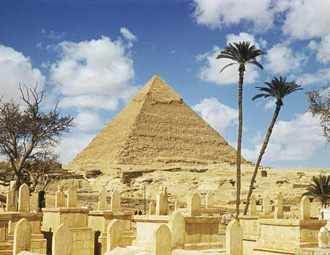
| | Originally 481 feet high, the Pyramid of Cheops was the tallest building in the world for four millennia until the completion of the Lincoln Cathedral in 1300 A.D. Today you can visit the Great Pyramid along with three other pyramids and the famous Egyptian Sphinx in a region called the Giza Plateau just outside Egypt's capital, Cairo. |
Constructed around the year 2560 B.C., the great Pyramid at Giza is the only wonder that remains standing from the original list of seven.

Egyptologists believe that the stunning monument, constructed from approximately 2 million blocks of stone and believed to have taken approximately 20 years and 20,000 men to complete, was built as a tomb for the fourth century Pharoah Khufu.

Throughout history, experts have marveled at the remarkable accuracy of the pyramid's construction. The base, which covers 13 acres, is almost a perfect square and each corner is aligned almost exactly with the four points on a compass.

Excavations have unearthed three chambers, known as the Unfinished Chamber, the Queen's Chamber and the King's Chamber. In addition, using a robot, researchers have explored many of the tunnels and alleyways that run deep into the monument.

The Hanging Gardens of Babylon

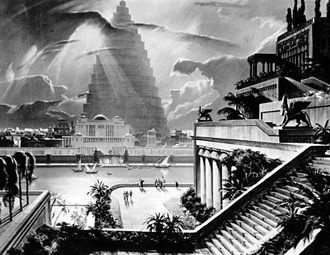
| | An artist's reconstruction of the ancient city of Babylon in 625 B.C. featuring the Hanging Gardens of Babylon and the Tower of Babel in the distance. Although researchers have not found any physical proof of the gardens, they have relied on descriptions from ancient writers who visited the gardens to visualize this wonder of the world. |
The Hanging Gardens of Babylon were reportedly a centerpiece of the ancient metropolis of Babylon (about 50 miles south of modern day Baghdad).

Strangely, the historical records of the Babylonians do not mention the wondrous hanging gardens, leading some scholars to doubt that they ever existed.

Regardless of the omission, stories of the gardens spread over time throughout the ancient world, and ancient writers recorded numerous descriptions.

The story goes that King Nebudchadnezzar II, who ruled in the seventh century B.C., built the hanging gardens to reproduce the mountain scenery that his wife was accustomed to from her homeland of Medina.

Despite the romantic image of gardens that floated in midair, many experts now agree that if they existed at all, the hanging gardens were an elaborate series of gardens "terraced" one on top of another on a hilly countryside.

The Statue of Zeus at Olympia

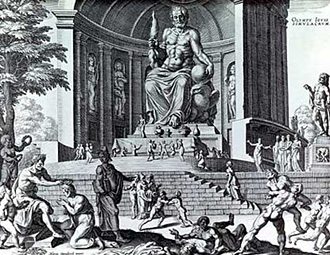
| | Standing more than 40 feet tall and constructed of ivory and gold, the statue of Zeus within the Temple at Olympia on the west coast of Greece was constructed around the year 435 B.C. and sat overlooking the grounds of the ancient Olympics. Re-creation by Marten Jacobszoon Heemskerk van Veen. |
Standing more than 40 feet tall and constructed of ivory and gold, the statue of Zeus within the Temple at Olympia (on the west coast of modern Greece) was constructed by the Greek sculptor Pheidias around 435 B.C.

The giant and stunning white statue sat overlooking the grounds where the original Olympic games were held, and people came from around the Greek empire to pay homage to Zeus and participate in the games.

Scholars agree that the statue remained in the temple for more than 800 years, but there is some debate about when and how the statue was destroyed. Some scholars believe that the statue was destroyed in a fire in the temple in the fifth century.

Others believe that the statue was transported from the temple to a palace in Constantinople, where it perished in a fire around the year 462.

The Temple of Artemis at Ephesus

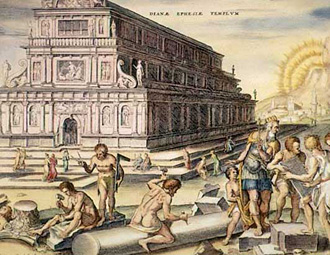
| | Built around the year 550 B.C., the great marble temple at Ephesus -- in modern-day Turkey -- was built in honor of Artemis, the Greek goddess of hunting and fertility. Today, visitors to the site can walk among the ruins of the great columns that once guarded the temple. Hand-colored engraving by Marten Jacobszoon Heemskerk van Veen. (1498-1574). |
Built around the year 550 B.C. by the architect Cherisphron, the great marble temple at Ephesus (located in modern day Turkey) was built in honor of Artemis, the Greek goddess of hunting and fertility.

The stunning marble structure was surrounded by 127 Ionic columns that reached to a height of 60 feet.

The facade of the temple was adorned with bronze statues attributed to a number of expert sculptors of the era and overlooked a courtyard that served as a marketplace for people from near and far to trade their goods.

On July 21, 256 B.C., the night of Alexander the Great's birth, a man named Herostatus burned the main building to the ground, hoping to make his name immortal. Another temple was reconstructed on the site but was destroyed by the Goths in the year 262.

The Mausoleum at Halicarnassus

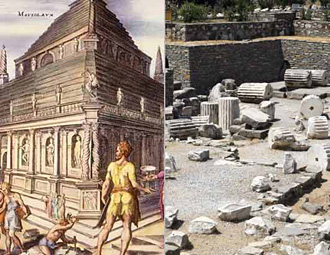
| Mausoleum at Halicarnassus
Admired for its stunning beauty, the Mausoleum at Halicarnassus in Bodrum, Turkey, was built as the tomb for the Persian King Mausollos of Caria by his wife and his sister around the year 353 B.C. On the left, a 1572 engraving by Marten Jacobszoon Heemskerk van Veen. On right, the ruins of the Mausoleum of Halicarnassus in 2006. |
Admired for its stunning beauty, the Mausoleum at Hailcarnassus (located near the modern city of Bodrum in Turkey) was built as the tomb for the Persian King Mausollos of Caria, and was completed around 35 B.C., a few years after Mausollos' death.

The Mausoleum, which no longer exists, was exceptional for its massive size, with a base of about 1,2000 square feet and a total height of 140 feet.

The burial chamber and the sarcophagus, which was built of white alabaster and adorned with gold, sat on top of a stepped podium and was surrounded by Ionic columns. Despite the Mausoleum's size, visitors were most impressed by the beautiful decorations and statues that adorned it.

Sixteen centuries after its construction, the Mausoleum was damaged by an earthquake, and in the early 15th century, crusaders destroyed what remained of the Mausoleum and used the bricks to build a castle that still stands today.

The Colossus of Rhodes

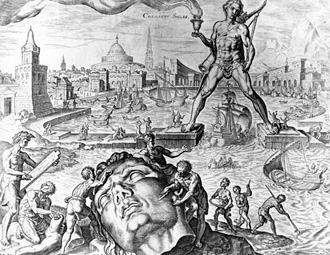
| | The Colossus of Rhodes straddles the harbor on the Greek island of Rhodes, circa 250 B.C. The statue, which stood 110 feet high, was a depiction of the sun god Helios. This is an engraving by Fialle after an original by Marten Jacobszoon Heemskerk van Veen. |
The 110-foot high statue of Colossus overlooked the ancient harbor of the Greek Island of Rhodes for only 56 years, but its size and construction inspired such awe in its visitors that centuries after its destruction it was included on the list of ancient wonders.

The people of Rhodes commissioned sculptor Chares of Lindos to build the giant bronze statue of their patron deity Helios the Sun God in 294 B.C. Sadly, in 238 B.C., Rhodes was hit by an earthquake and the city's beloved Colossus fell. However, according to historical accounts, visitors to Rhodes were still awed by the statue even as it laid in ruins on the ground.

In 652, an invading Arab army destroyed the fallen Colossus, and some historical accounts assert that the army then sold off the pieces to "a Jew from Syria" who transported them on the backs of "900 camels."

The Lighthouse (Pharos) of Alexandria

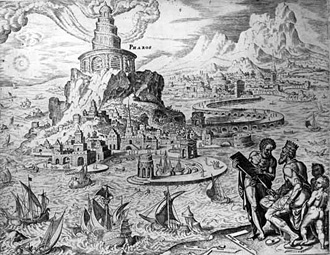
| | Built on the ancient island of Pharos, just off the coast of Alexandria, Egypt, around 305 B.C., the lighthouse reached more than 400 feet high and was one of the tallest man-made structures on Earth for many centuries. Re-creation from circa 100 B.C. |
The Lighthouse of Alexandria was located on the ancient island of Pharos, just off the coast of the Egyptian city of Alexandria. Designed by Sostratus of Cnidus in the third century B.C., construction of the lighthouse did not begin until 305 B.C., during the rule of Ptolemy Soter.

The lighthouse, constructed of large blocks of stones, reached a height of about 400 feet and was one of the tallest structures created by man for many centuries. Initially the structure was intended only as a landmark for ships attempting to navigate into the harbor at Alexandria, but in the first century, the Romans transformed it into a lighthouse by lighting a fire at night and using reflecting mirrors during the day.

After 16 centuries guiding ships to safety, two earthquakes severely damaged the revered lighthouse. And in 1480, the Sultan of Egypt, Qaitbay, razed the remaining ruins and built a medieval fort on the site incorporating some of the original stone from the lighthouse. | 
 | |
 |



